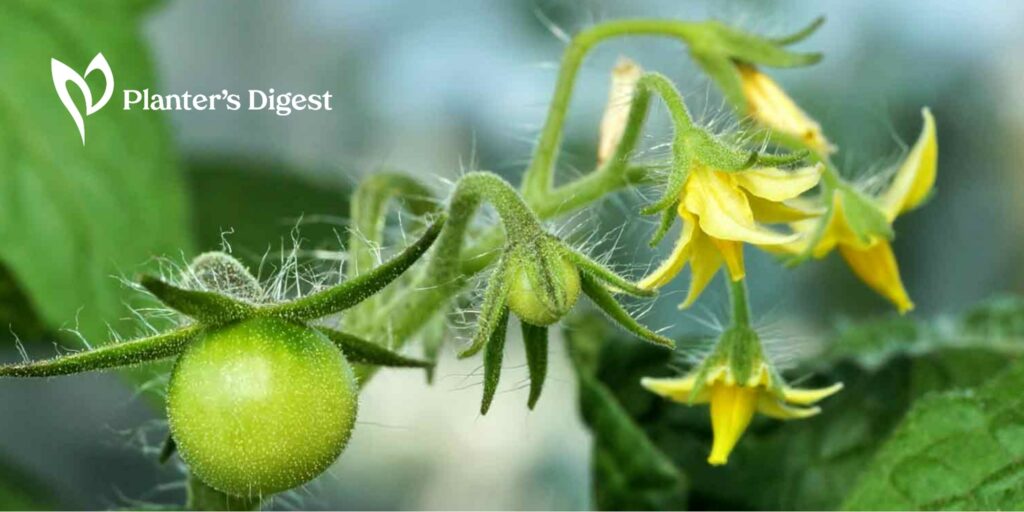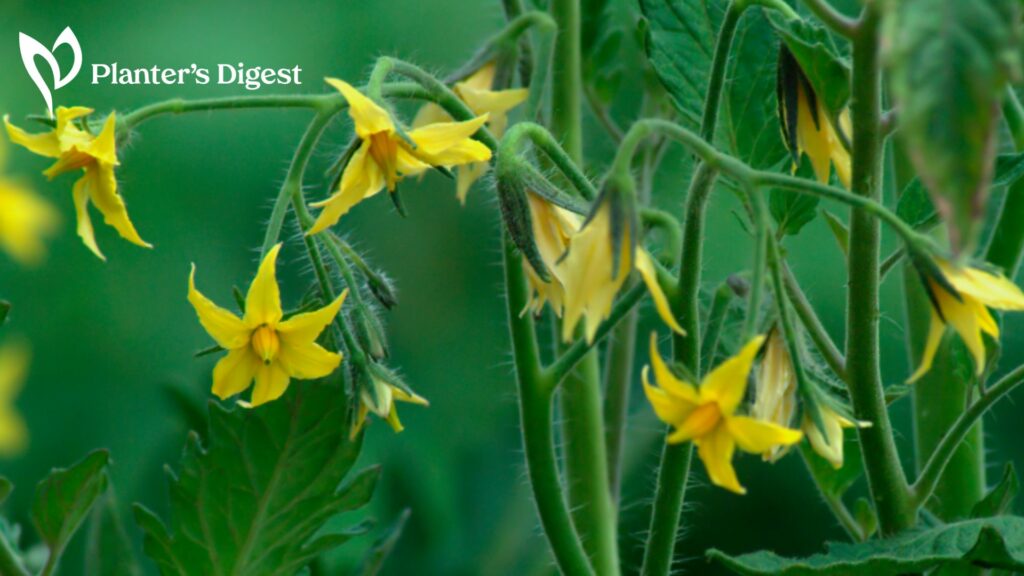If your tomato plant has flowers but no fruit, it could be due to several reasons. Tomatoes are sensitive plants, and various factors can impact their fruiting process.
Tomatoes can self-pollinate. This means that the pollen from the male parts of a flower can fertilize the female parts of the same flower, resulting in the production of fruit.
Yet, tomatoes don’t just rely on self-pollination. They often benefit from cross-pollination, which occurs when insects, wind, or other outside influences transfer pollen between flowers.
But if you’re still frustrated and puzzled about not having fruits, worry no more! We’re here to help you get to the bottom of things.
Why does my tomato plant have flowers, but no fruit?
Self pollinating tomatoes don’t produce fruit for several reasons, which can include pollinators and external stimuli, humidity, temperature extremes, and nutrient deficiencies.
On top of that, watering issues, stress factors, variety-specific traits, insufficient sunlight, and early planting can contribute to non-fruiting but flowering tomato plants.
Tomatoes are self-pollinating because they have flowers containing both male and female parts. This means they can reproduce without the need for multiple plants.
However, if you’re facing problems, there might be one or more reasons for it.
Variety-Specific Traits
The Fix: Care for Your Specific Variety Correctly
Growing tomatoes can be quite rewarding. Most of the time, it’s a delightful experience.
However, you need to remember that different tomato varieties have their own quirks. They’re pretty much like humans, to be honest!
For instance, some types are more prone to flower drop. Others tend to have specific requirements for fruit-bearing, so you have to be more mindful.
This is especially true if you’re growing an heirloom or non-hybrid variety. Get ready to encounter unique characteristics that can influence their fruit production!
How to Care for Your Specific Variety Correctly
1. Select the perfect tomato variety.
Got for tomato types celebrated for their fruiting traits, like determinate or indeterminate variations, that match your growing conditions.
2. Prep your soil the right way.
Regardless of tomato variety, guarantee the soil is both well-draining and nutrient-rich, with a pH ranging from 6.0 to 6.8. Enhance it by incorporating compost and organic matter prior to planting.
3. Provide sturdy support systems, especially for larger varieties.
Use stakes, cages, or trellises to prop up indeterminate varieties, which improves air circulation and prevents fruits from coming into contact with the ground.
4. Give the care your tomatoes deserve.
Offer your tomatoes the precise care they need to keep them from getting stressed.
Stress Factors
The Fix: Properly Care for Your Tomatoes
The tomato plant can face stress from pests, diseases, or extreme weather. When dealing with these, the plant will tend to prioritize survival instead of fruit production.
It’s good for the plant in one way, and bad for the plant in another way.
| Factors | Level |
| Ease of Activity | Moderate ●●○○○ |
| Maintenance Level | Moderate |
| Estimated Costs | Low |
| Possible Risks | Low |
How to Properly Care for Your Tomatoes
1. Water correctly.
Provide consistent and adequate watering to prevent stress from either too little or excessive water. Go for deep and even moisture levels, as this is crucial for the healthy development of tomatoes.
2. Provide proper fertilization.
Ensure a balanced nutrient supply by regularly fertilizing your tomato plants. Go for a fertilizer with higher potassium content to encourage flowering and the formation of fruits.
3. Apply mulch.
Mulch around the base of the plants to maintain consistent soil moisture levels. Mulching also helps in regulating soil temperature and reducing stress caused by sudden temperature changes.
4. Ensure enough sunlight.
Give your tomato plants a minimum of 6 to 8 hours of direct sunlight daily. Ample sunlight is essential for robust growth and fruitful yield.
5. Protect from extreme temperatures.
Shield your plants from extreme temperatures, whether hot or cold. Consider using shade cloth or row covers to minimize stress caused by temperature fluctuations.
6. Prune as needed.
Trim excessive foliage to enhance air circulation and direct the plant’s energy toward fruiting. Promptly remove yellowing or diseased leaves to prevent stress.
7. Manage and prevent pests and diseases.
Regularly monitor your plants for signs of pests and diseases. Quickly address any issues using integrated pest management techniques to prevent stress.
8. Support your tomatoes.
Provide appropriate support to prevent the breaking of branches due to the weight of growing fruit, even smaller ones that tend to produce numerous fruits.
9. Help with pollination if needed.
If pollinating insects are scarce, gently shake the plants to facilitate pollination.This step can contribute to fruit development.
Pollinators and External Stimuli
The Fix: Provide Access to Pollinators and External Stimuli
Tomatoes are usually self-pollinating. However, they can do even better with some help!
Pollinators like bees and butterflies are important to all plants, not just tomatoes. They move pollen between flowers, helping them grow fruits.
Wind can also shake flowers, spreading pollen. But if your garden doesn’t have these helpers, you might need to step in.
| Factors | Level |
| Ease of Activity | Low ●○○○○ |
| Maintenance Level | Low |
| Estimated Costs | Low |
| Possible Risks | Low |
How to Provide Access to Pollinators and External Stimuli
1. Grow companion plants.
Place marigolds, zinnias, and bee balm close to your tomato plants. These flowers naturally attract pollinators, fostering an environment that encourages interaction with your tomatoes.
2. Reduce the use of strong pesticides that could harm helpful insects and pollinators.
Whenever possible, go for gentler alternatives. If you notice a lack of pollinators, consider resorting to manual pollination.
3. Complement with manual pollination.
Use a small brush, cotton swab, or even a simple stick to gently transfer pollen among the flowers. These tools allow for precise pollen distribution.
If you lack these items, softly tapping the flowers can also effectively release pollen.
4. Supplement with wind power.
Set up a small fan near your tomato plants to enhance airflow. This can greatly enhance pollination, especially during the crucial pollination phase.
Humidity
The Fix: Manage and Provide Adequate Humidity
High humidity levels can impact pollen viability and the pollination process. When there’s too much moisture, pollen can clump together.
This can make it difficult for the pollen to travel to the flower stigma. As a result, there may be reduced or delayed fruit set.
| Factors | Level |
| Ease of Activity | Moderate ●●○○○ |
| Maintenance Level | Moderate |
| Estimated Costs | Low |
| Possible Risks | Moderate |
How to Manage and Provide Adequate Humidity
1. Give each tomato plant enough space to grow without crowding.
This practice promotes good airflow around the plants and reduces the risk of diseases caused by overly moist conditions.
2. Water at the base of the plant.
When you water your tomato plants, remember to water them directly at the soil’s base. Avoid watering from above, as this can result in damp foliage. Leaves and flowers that stay wet are vulnerable to problems caused by prolonged exposure to moisture.
3. Consider mulching.
Mulch helps retain moisture in the soil, reducing the need for frequent watering and preventing rapid soil drying. By maintaining consistent soil moisture, mulch also helps regulate humidity levels around the plants.
This is especially helpful in avoiding excessively humid conditions that can encourage fungal growth.
Temperature Extremes
The Fix: Control and Manage Temperature
Tomatoes are sensitive to temperature fluctuations. If the temperature is too high or too low during the flowering stage, it can prevent fruit set.
Extremely high temperatures can cause the flowers to drop. Cold temperatures, on the other hand, can hinder pollination and fruit development.
When temperatures rise above 85 to 90 F, depending on humidity, pollen becomes unviable. Did you know that humidity also affects pollination? You do now!
In extremely humid regions, pollen may become too sticky and not fall. In arid regions, pollen may become too dry and not stick to the female part of the flower.
Gardeners often try to shake the plant gently to encourage pollination, but sometimes it just won’t work. Humidity can influence temperature fluctuations too!
High humidity levels can worsen temperature stress on the plant, especially during hot weather. This can lead to flower drop and hinder fruit formation.
| Factors | Level |
| Ease of Activity | Moderate ●●○○○ |
| Maintenance Level | Low |
| Estimated Costs | Low |
| Possible Risks | Low |
How to Control and Manage Temperature
1. Provide shade from excess heat and light.
Protect your tomatoes from excessive heat as it can harm their health. Go for shade cloth, a practical choice that shields plants from intense sunlight.
To protect the more delicate tomato varieties, consider planting taller companion plants strategically. This setup provides natural protection against harsh sunlight.
2. Protect tomatoes from extreme cold.
Use row covers or cloches to shield young plants from freezing temperatures and potential frost damage.
Over-Fertilization and Nutrient Deficiencies
The Fix: Fertilize Properly
Now, if you use too much nitrogen fertilizer, the plant may grow excessively and become bushy. It can look nice, to be honest.
However, this growth may come at the cost of fruit production. What could be the result, you ask?
You might see very few flowers on the plant, if any at all. Unfortunately, these flowers might not develop into any fruits!
Fruit development also relies on essential nutrients like phosphorus, potassium, and calcium. These elements act as natural building blocks for plants.
However, if they are found lacking, you can expect to see poor growth from your tomatoes.
| Factors | Level |
| Ease of Activity | Moderate ●●○○○ |
| Maintenance Level | Low |
| Estimated Costs | Low |
| Possible Risks | Moderate |
How to Fertilize Properly
1. Choose a balanced fertilizer specifically formulated for tomatoes.
This provides essential nutrients to support their development. Exercise caution when applying fertilizer, and avoid overusing nitrogen-rich fertilizers.
2. Correct nutrient imbalances.
Too much nitrogen can lead to an overgrowth of leaves and hinder the production of fruits. Go for a balanced approach to prevent this from happening.
Watering Issues
The Fix: Water Correctly
Inconsistent watering is not good for your plant, in case you didn’t know. It can stress the plant and cause problems like flower drop and poor fruit set.
Roots can get dry. Pretty soon, you might end up with wilting plant parts, yellowing leaves, or curled foliage!
| Factors | Level |
| Ease of Activity | Moderate ●●○○○ |
| Maintenance Level | Low |
| Estimated Costs | Low |
| Possible Risks | Low |
How to Water Correctly
1. Maintain a consistent watering schedule.
Stick to a routine and avoid deviating from it. Consistent watering plays an important part in preventing plant stress and promoting steady, healthy growth.
2. Water the plants directly at their base.
This approach minimizes the risk of accidental leaf damage and reduces the likelihood of fungal infections.
3. Time your watering correctly.
The best time to water your plants is in the morning. This gives the soil enough time to slightly dry out by the evening, creating a healthy environment for your plants.
Insufficient Sunlight
The Fix: Prune as Needed
Tomatoes are the exact opposite of vampires. They need plenty of sunlight for fruit production!
In fact, if they don’t get enough sunlight, they just might prioritize leaf growth over fruit development.
| Factors | Level |
| Ease of Activity | Moderate ●●○○○ |
| Maintenance Level | Moderate |
| Estimated Costs | Low |
| Possible Risks | Low |
How to Prune as Needed
1. Determine the parts of the plant to prune.
Look for areas that are heavy with foliage, as these can prevent air circulation, increase humidity, and prevent sunlight penetration..
2. Lightly prune the tomato plants to maintain a manageable size and shape.
This practice not only contributes to the aesthetics but also offers functional benefits.
Early Planting
The Fix: Time Tomato Planting Correctly
Another possibility of having flowers but no fruits is that you planted your tomatoes too early in the season. At this critical time, the temperatures were still quite low.
Due to this, it could have impacted the development of flowers and the setting of fruits. After all, tomatoes prefer warmth over the bitter cold!
| Factors | Level |
| Ease of Activity | Moderate ●●○○○ |
| Maintenance Level | Low |
| Estimated Costs | Low |
| Possible Risks | Low |
How to Time Tomato Planting Correctly
1. Pick the right varieties.
In the planning stage, pick tomato types that match your local climate. Do some research or ask local gardening sources for advice on the top choices in your area.
2. Plant your selected varieties at the right time.
Avoid planting tomato seedlings too early, especially if the temperatures are still low. Cold weather can harm the growth of flowers and fruits.
It’s better to wait until the weather has warmed up enough before you start your tomato gardening endeavors.
How to Hand Pollinate Tomatoes
There are times when our tomato plants need all the help they can get. This can be in the form of hand-pollination, and there are different ways to do that.
Shake the Stakes
| Factors | Level |
| Ease of Activity | Low ●○○○○ |
| Maintenance Level | Low |
| Estimated Costs | Low |
| Possible Risks | Low |
How to Shake the Stakes to Pollinate
Gently shake the tomato stakes or cages to mimic the vibration caused by wind, helping pollen move between flowers.
Electric Toothbrush
| Factors | Level |
| Ease of Activity | Low ●○○○○ |
| Maintenance Level | Low |
| Estimated Costs | Low |
| Possible Risks | Low |
How to Use Electric Toothbrush to Pollinate
Use a clean, unused electric toothbrush to vibrate the flower clusters. Gently touch the vibrating toothbrush to the flowers to release pollen.
Paintbrush or Q-tip
| Factors | Level |
| Ease of Activity | Low ●○○○○ |
| Maintenance Level | Low |
| Estimated Costs | Low |
| Possible Risks | Low |
How to Use Paintbrush or Q-tip to Pollinate
Gently transfer pollen from the stamens of one flower to the pistil of another using a small paintbrush or a cotton swab.
Flicking
| Factors | Level |
| Ease of Activity | Low ●○○○○ |
| Maintenance Level | Low |
| Estimated Costs | Low |
| Possible Risks | Low |
How to Flick to Pollinate
Gently flick or tap the flowers with your finger to release pollen. This mimics the action of pollinators brushing against the flowers.
Breeze from a Fan
| Factors | Level |
| Ease of Activity | Low ●○○○○ |
| Maintenance Level | Low |
| Estimated Costs | Low to Moderate |
| Possible Risks | Low |
How to use Breeze from a Fan to Pollinate
Position a small fan near your tomato plants to create a gentle breeze. This can help move pollen between flowers.
Tapping
| Factors | Level |
| Ease of Activity | Low ●○○○○ |
| Maintenance Level | Low |
| Estimated Costs | Low |
| Possible Risks | Low |
How to Tap to Pollinate
Tap the stem or branches of the tomato plant to encourage pollen release. Do this while hovering over a receiving flower.
Vibrating Wand
| Factors | Level |
| Ease of Activity | Low ●○○○○ |
| Maintenance Level | Low |
| Estimated Costs | Low |
| Possible Risks | Low |
How to Use Vibrating Wand to Pollinate
Create a simple vibrating tool using a stick or straw. Gently touch the flower clusters to transfer pollen using the vibrating end.
Hand Vibration
| Factors | Level |
| Ease of Activity | Low ●○○○○ |
| Maintenance Level | Low |
| Estimated Costs | Low |
| Possible Risks | Low |
How to Do Hand Vibration to Pollinate
Gently vibrate the stem or flower cluster between your fingers to release pollen.
Use Tomato Blossom Set Sprays as Last Resort
| Factors | Level |
| Ease of Activity | Moderate ●●○○○ |
| Maintenance Level | Low |
| Estimated Costs | Moderate |
| Possible Risks | Low |
Tomato blossom set spray is often referred to as a pollination spray. However, that’s not entirely accurate since it doesn’t actually cause pollination.
These sprays are commonly used in commercial greenhouses. The aim is to encourage flowers to produce fruit without releasing pollen.
When you use tomato blossom set spray, the entire pollination process is bypassed. However, there is a downside to using this spray.
Although the resulting tomato fruit may develop correctly, the seeds won’t be viable. So, if you’re someone who likes to save seeds, this isn’t the right pollination method for you.
For organic gardeners, tomato blossom set spray probably isn’t the best choice. Other methods we’ve mentioned earlier would be more suitable, and to be honest, we prefer them too because they take a more natural approach!
How to Use Tomato Blossom Set Spray
1. Time correctly.
Start using the blossom set spray as soon as you spot the first flowers on your tomato plants.
2. Spray in the evening.
Choose the evening for your spraying activities, when the sun has mellowed down and things are cooler. This keeps your plants happy and stress-free.
3. Read and follow product instructions.
Read the product label. It’s your recipe for the right mix and how to apply it.
Most of these sprays need to be mixed with water, so follow the right ratio.
4. Aim for the flowers.
Spray that mix you’ve got directly on those blossoms. Make sure each and every flower gets some love so you get the best results.
5. Spray regularly.
Be ready to spray more than once. Depending on the product and how your plants are doing, hit them with the spray every 7 to 10 days.
6. Make sure your plants are not under stress.
Hold off if your plants are stressed or it’s crazy hot. Also, double-check that the spray you’re using is okay for edible stuff.
7. Monitor and adjust.
Keep an eye on your plants. Watch how the spray affects how your fruit forms and how your whole plant grows.





